What Is an Ecommerce Website?
An ecommerce website is any site that facilitates the buying and selling of products and services.
Digital marketplaces, online retail stores, and auction sites are considered ecommerce sites because they enable consumers to buy goods.
Any business owner with a product or service to sell can benefit from an ecommerce site, including the following:
- A small business trying to get local customers
- A freelancer selling their services
- A large corporation showcasing its products
What Is Ecommerce?
Ecommerce, which stands for “electronic commerce,” is the buying and selling of products and services over the internet. This includes all types of industries, such as retail, electronics, grocery, education, entertainment, delivery, and more.
According to Statista, revenue in the U.S. ecommerce market is predicted to grow 43.58% between 2024 and 2028. This increase in growth is forecasted to be worth $462.7 billion U.S. dollars.
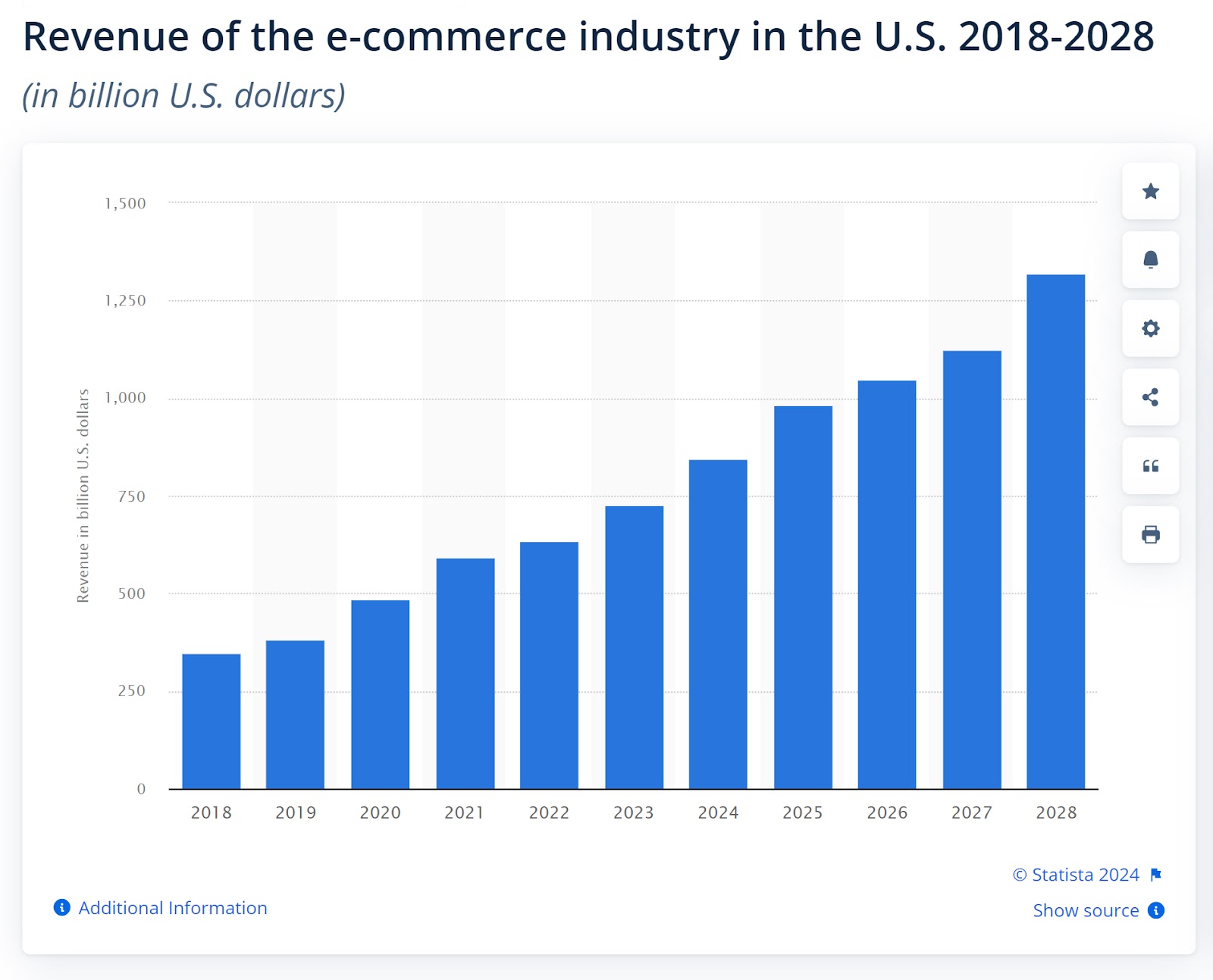
How Does Ecommerce Work?
Ecommerce works in multiple ways: Merchants can create their own ecommerce site, set up an online store on an ecommerce platform like Shopify or Magento, or create a storefront on a marketplace like Amazon or eBay.
Regardless of the method, all stores must have secure payment gateways to facilitate payments and comply with Payment Card Industry (PCI) Data Security Standards.
Here’s a look at the process:
- Shoppers visit an online store or website and browse products using a variety of devices, such as smartphones, laptops, desktops, tablets, and smart TVs and watches.
- Customers typically add the products they want to buy to a virtual shopping cart. The shopping cart keeps track of selected items, quantities, and total costs.
- When customers are ready to purchase, they proceed to the checkout page. They provide shipping information, select a payment method, and review their order before finalizing the purchase.
- The seller receives a notification of the order
- The vendor then prepares the products for shipping to the customer
An excellent example of an ecommerce website is the eBay marketplace. Shoppers search for specific products using the search bar or relevant product categories on the main menu.
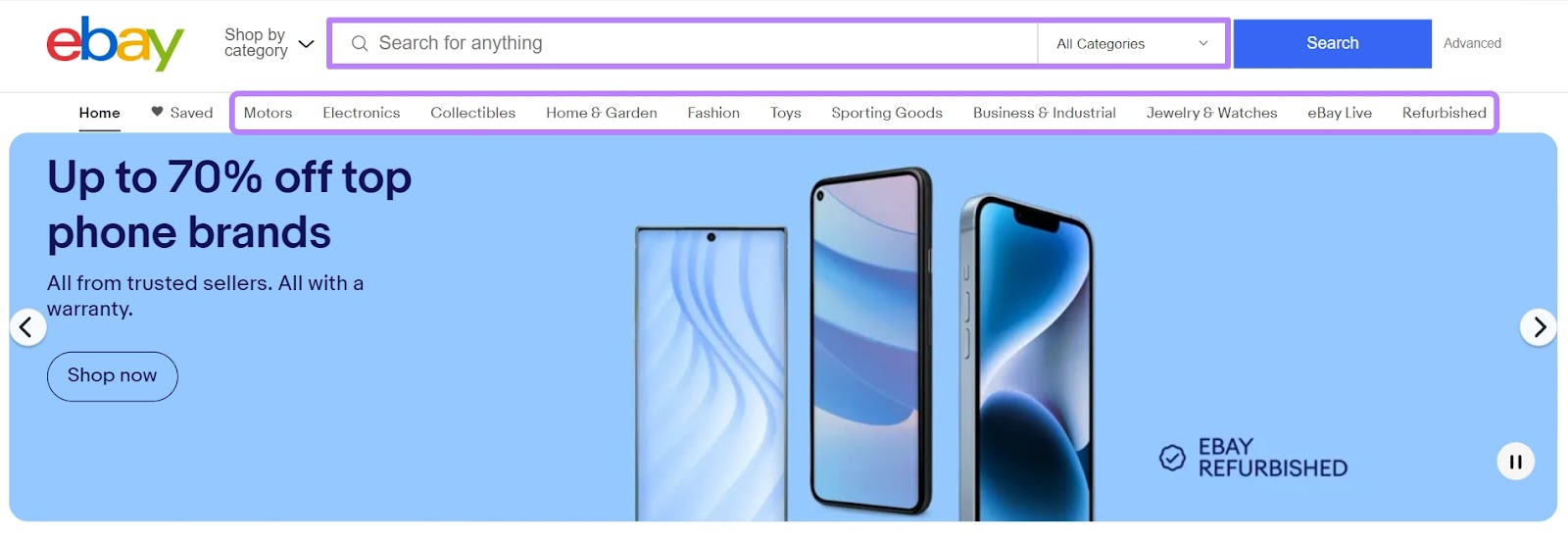
What Should an Ecommerce Site Do?
A great ecommerce site can do a variety of things, from helping you sell your products to providing an excellent user experience (UX) for customers.
Here’s a look at what ecommerce sites should have in order to successfully meet website owners’ (and users’) needs:
- User-friendly interface: Ensure intuitive navigation and easy access to products and services
- Secure payment gateway: Implement SSL certificates and PCI compliance for safe transactions
- Product catalog: Organize products into categories with detailed descriptions and high-quality images
- Shopping cart: Allow users to add, remove, and modify items before checkout
- Mobile responsiveness: Optimize the site for seamless viewing and functionality across various devices
- Search functionality: Enable users to quickly find specific products or categories
- Customer reviews and ratings: Provide social proof and aid in decision-making for potential buyers
- Order management system: Track orders, manage inventory, and process shipments efficiently
- Customer support: Offer multiple channels for assistance, such as live chat, email, and phone support
- Analytics and reporting: Monitor site performance, track user behavior, and gain insights for optimization
- Legal compliance: Ensure adherence to data protection laws, terms of service, and privacy policies
- SEO optimization: Optimize content and metadata to improve search engine rankings and visibility
- Mobile optimization: Google recommends that content on mobile pages should load in under 3 seconds.
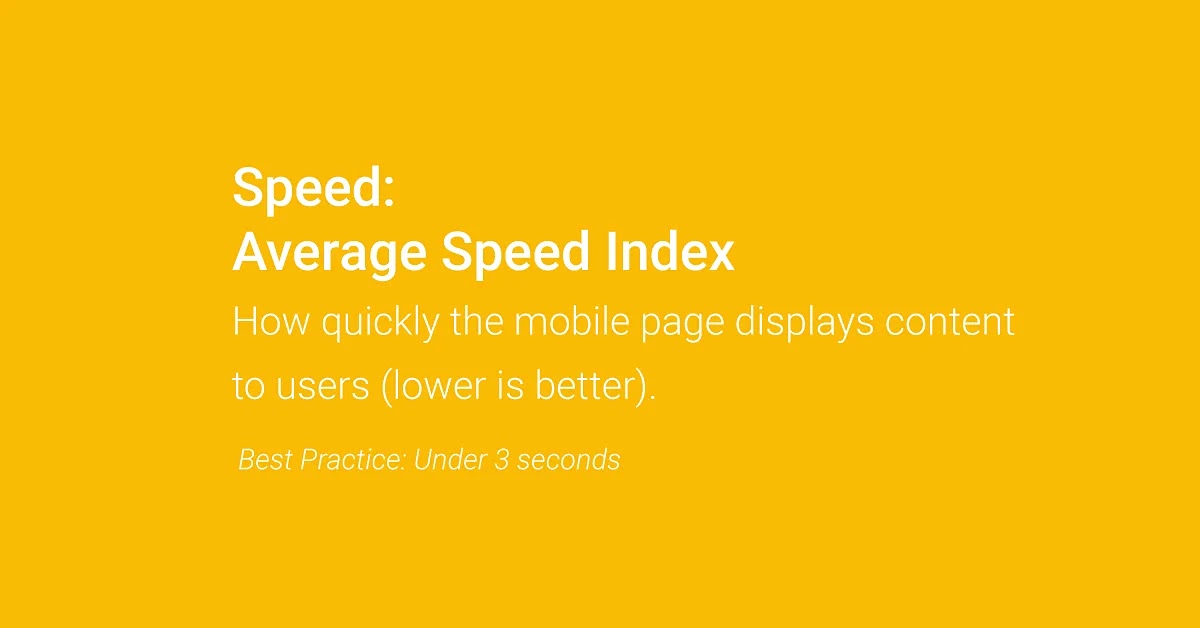
Image Source: Think with Google
If business owners don’t have the budget or time to invest in creating a high-quality ecommerce site, established online marketplaces or online stores that provide these features can be a great alternative.
Further reading: UX and SEO: The Best Strategy for Getting Results
Types of Ecommerce Businesses Explained
Ecommerce comes in many forms. Here’s a quick rundown of the major ecommerce business types.
Business-to-Consumer (B2C)
A B2C business is an online business that sells goods or services directly to individual consumers.
A B2C website example is Alfred, an online coffee shop that sells coffee products. Customers can buy coffee online from this site and even set up subscriptions at their preferred frequency.
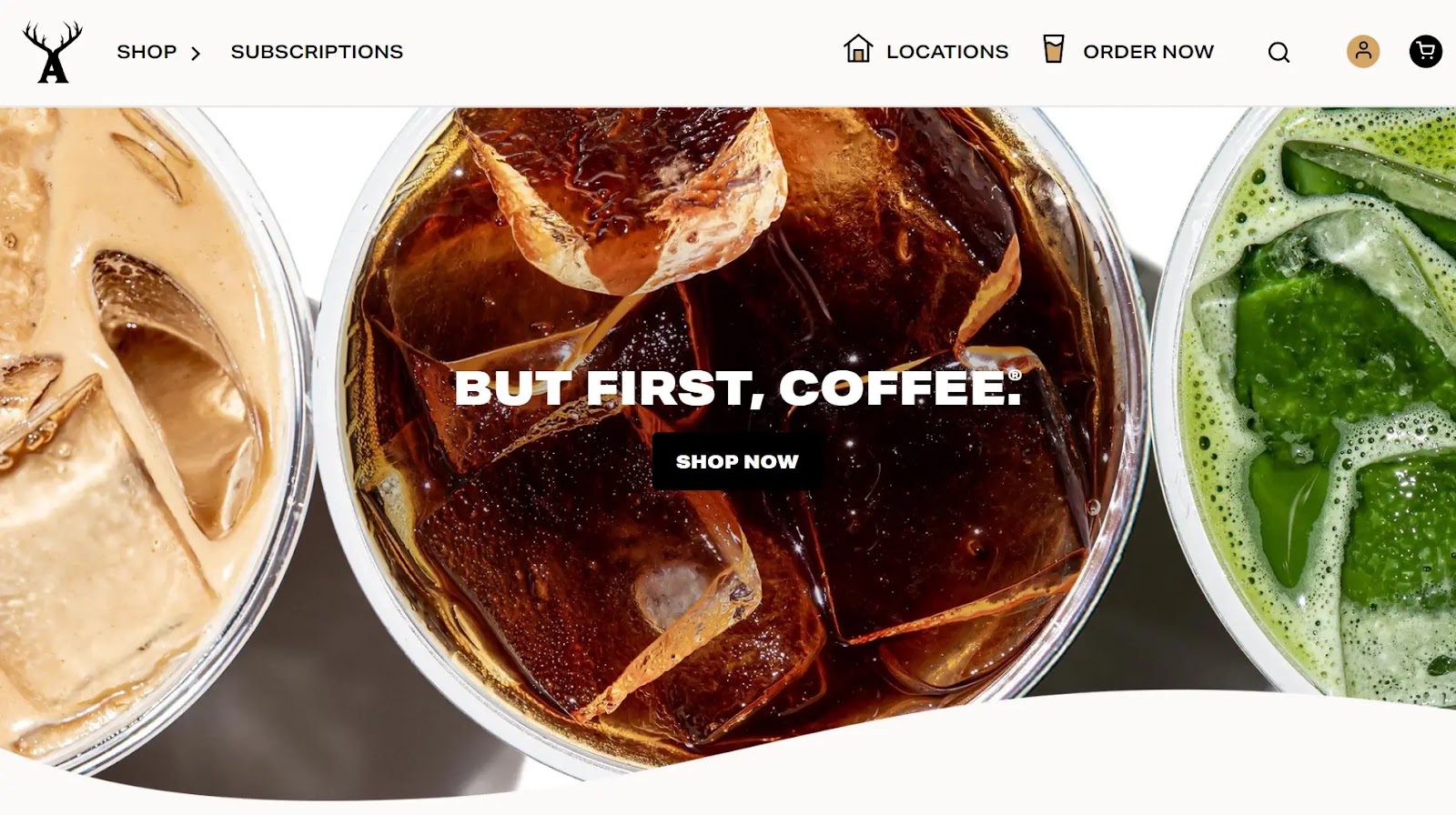
Business-to-Business (B2B)
B2B ecommerce is when a business sells goods or services to another business over the internet.
B2B transactions are primarily between a wholesaler and a retailer, or a manufacturer and a wholesaler.
Alibaba is a B2B marketplace that sells clothes, machinery, and consumer electronics to business owners.
Business-to-Government (B2G)
B2G is an ecommerce model where a business sells products to the government (local, county, state, or federal).
Companies place bids to win government contracts.
For example, pharmaceutical and biotechnology giant Pfizer won a billion-dollar deal to supply the U.S. government with COVID-19 vaccines in 2022.

Consumer-to-Consumer (C2C)
C2C is a business model in which consumers sell goods or services to other consumers.
Online marketplaces provide a platform for consumers to interact and transact in a secure environment.
For instance, consumers can buy and sell baby care products, furniture, mobile phones, and more on Facebook Marketplace.
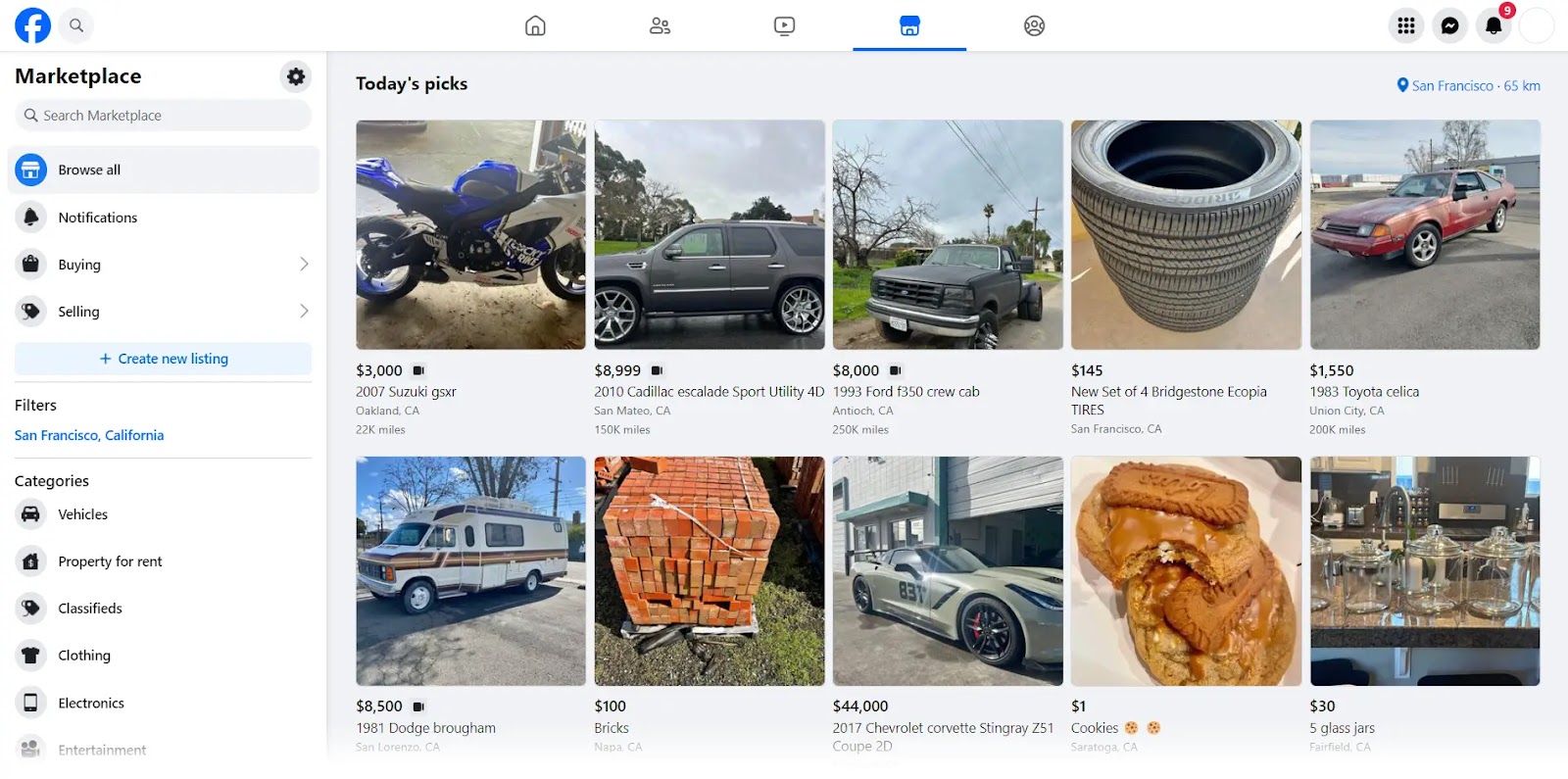
Consumer-to-Business (C2B)
The C2B model is when an individual sells physical products or services to a company.
For example, an independent freelance writer can advertise their services (write ebooks, blog posts, or social media content) to businesses on a site like Upwork. Businesses and individuals can then buy these services on the platform.
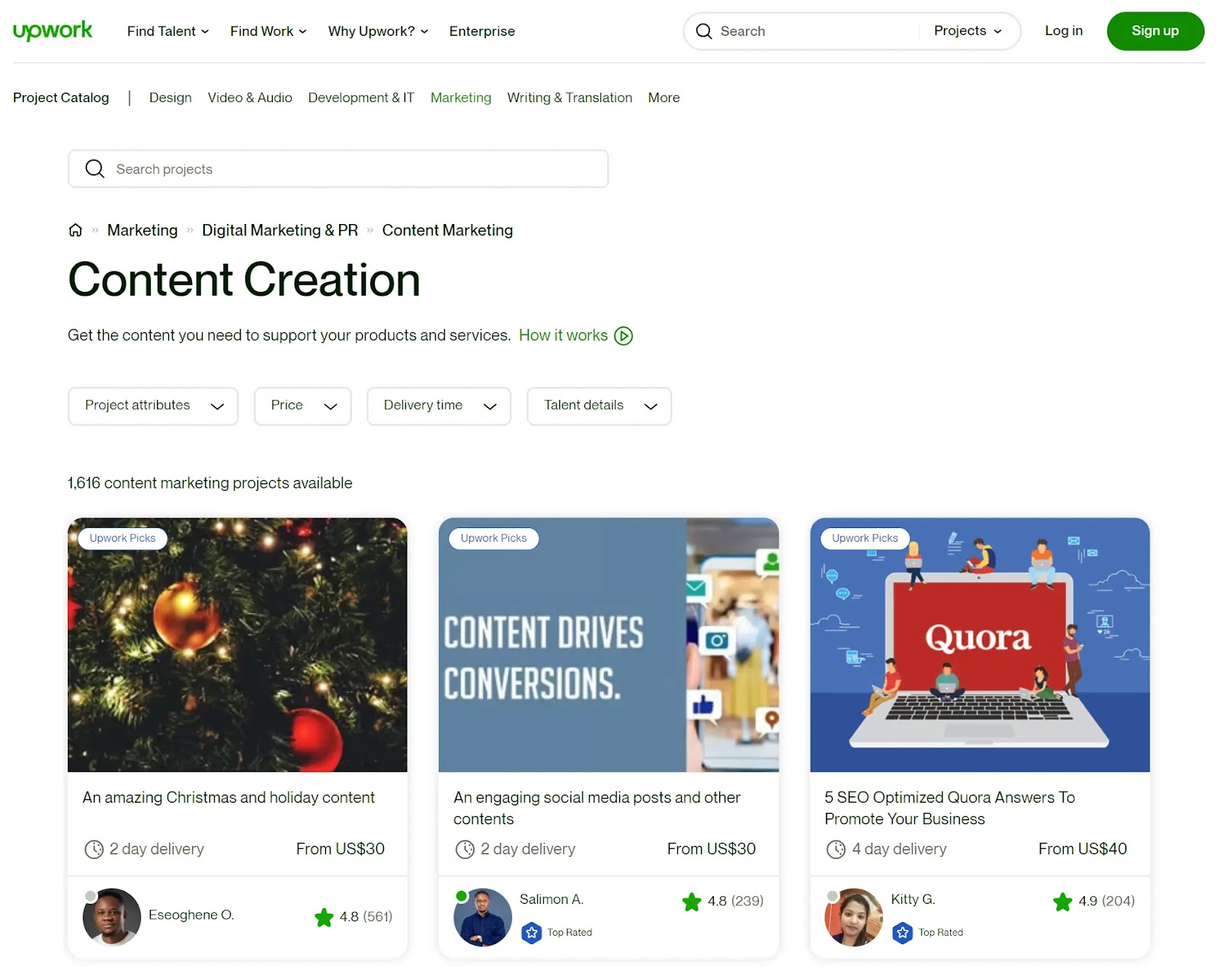
Consumer-to-Government (C2G)
C2G ecommerce refers to transactions between a consumer and various government entities.
In the C2G model, consumers interact with government agencies directly and gain access to government services through an online platform.
For example, company owners can register their businesses online on the official U.S. Small Business Administration website.
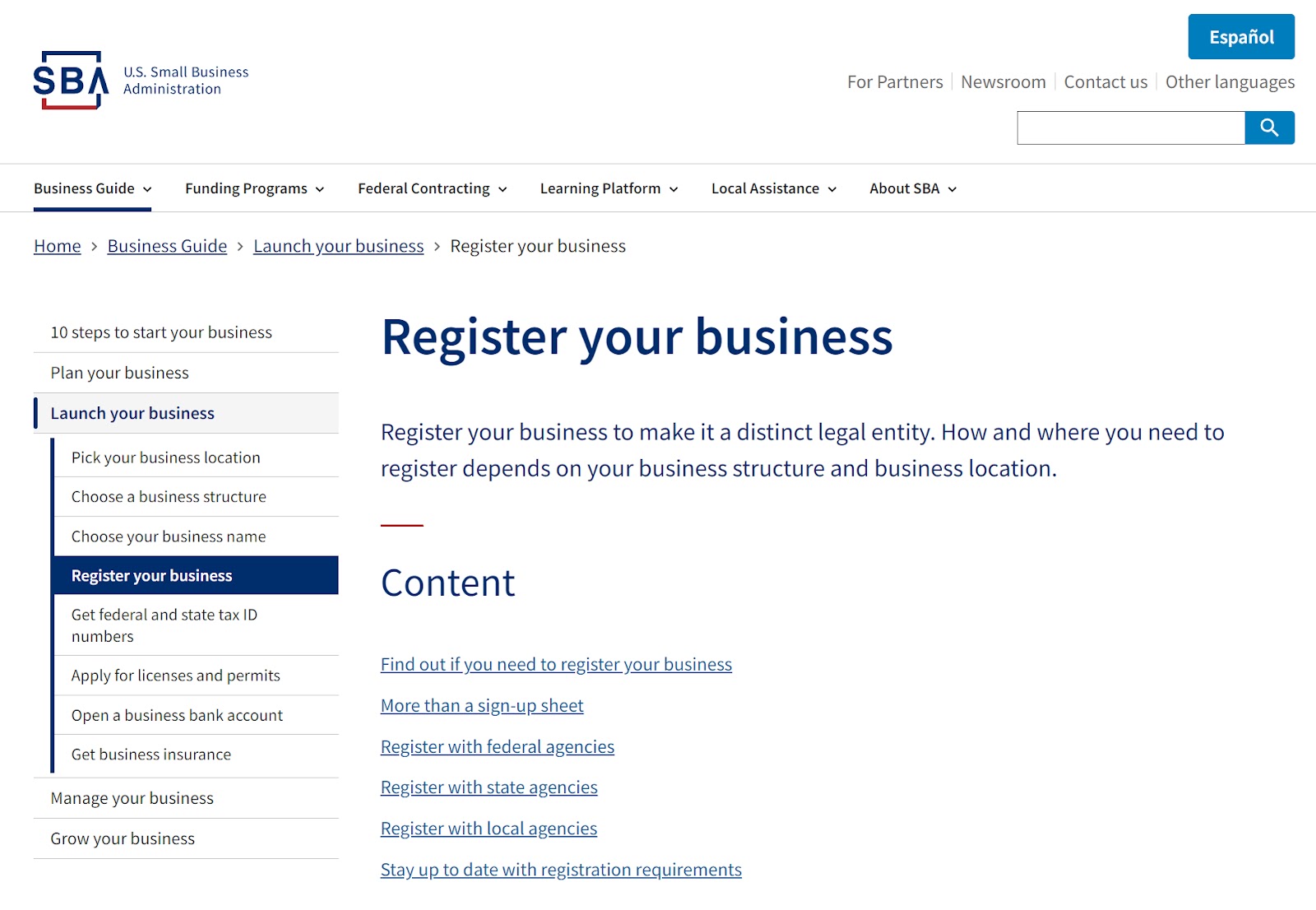
Further reading: 9 Profitable Ecommerce Business Ideas for Your Next Venture
The Benefits of Ecommerce Businesses
Buying and selling goods online has many benefits for both buyers and sellers.
- Wider reach: Allows businesses to expand beyond their local area, reaching regional or global markets
- Convenience: Offers flexibility and convenience, allowing consumers to shop anytime, anywhere
- Low costs: Reduces the need for physical space, cutting down on rent, utility bills, and property taxes
- Customer data: Provides access to valuable customer data, including purchase history and preferences, helping you choose products and improve the experience
- Faster service: Speeds up the buying process with smart automation, rapid browsing, and quick ordering systems
- Payment flexibility: Caters to customer preferences and enhances the shopping experience
- Affordable marketing and advertising: More cost-effective than traditional advertising methods
- Facilitates international trade: Breaks down geographical barriers, making it easier for businesses to enter international markets
The Challenges of Ecommerce Businesses
While ecommerce offers many benefits to business owners, it also comes with challenges.
- Ensuring website security: With the increase in online transactions, maintaining a secure platform is vital. This challenge provides an opportunity to earn customers' trust by implementing robust security measures.
- Managing inventory: Keeping track of stock levels can be tricky, but it's also an opportunity to streamline operations and reduce overheads
- Attracting traffic: Creative marketing strategies, like email and content marketing, can help draw in potential customers.
- Cart abandonment: 70.19% is the average shopping cart abandonment rate. Certain marketing tactics, like cart abandonment emails, can help recover these sales.
- Retaining customers: Building a loyal customer base can be challenging, but it also means opportunities to engage with customers and create lasting relationships
- Handling returns and refunds: Although managing returns can be complex, a smooth process can significantly enhance customer satisfaction
- Dealing with competition: A competitive market pushes businesses to continually evolve and improve their offerings
- Adapting to market changes: The ever-changing ecommerce landscape requires businesses to stay flexible and adaptable, fostering a culture of innovation and responsiveness.
How to Start a Successful Ecommerce Business
Starting an ecommerce business consists of a series of steps to set up your online store, source or create your products, and promote your website.
Here's a step-by-step guide to help you launch your ecommerce venture.
1. Conduct Market Research
Before you can even think about products or selling, conduct market research on your business idea. Here’s how:
Identify Your Target Market and Niche
Find out who your ideal customers are using tools like Google Analytics and Facebook Audience Insights. These tools can help you discover the size, demographics, interests, and behaviors of your potential market and niche.
Analyze Competitors
To learn from your competitors’ strengths and weaknesses, use our Competitive Research Toolkit.
The toolkit allows you to compare your website to competitors in key areas like traffic, keywords, pages, backlinks, and social media.
Find opportunities your competitors are missing using the Keyword Gap tool. To see which keywords your competitors are ranking for so you can outrank them.
2. Handle Legal Matters
Registering a business isn’t mandatory for all types of businesses, but it has many benefits that can help new entrepreneurs.
For example, registering a business can help you:
- Open a business bank account and access financial services
- Get funding from investors
- Enjoy tax advantages and deductions
- Protect your personal assets and limit your liability
- Enhance your reputation and credibility with customers and suppliers
- Comply with legal and regulatory requirements
Generally, sole proprietorships and partnerships do not need to register their business unless they want to use a trade name or a fictitious name for their business
On the other hand, corporations and limited liability companies (LLCs) must register their business in the state where they operate. These types of businesses have a separate legal entity from their owners and offer more protection and flexibility.
You can register your business online and learn more about the process on the official U.S. Small Business Administration (SBA) website.
The cost of registering a business varies from state to state, but according to the SBA, it’s typically less than $300.
You’ll need the following information to register your business:
- Business name
- Business location
- Ownership, management structure
- Registered agent information
- Number and value of shares (for a corporation)
The documents you’ll need vary according to your business type and state.
3. Buy a Domain Name
Buying a domain name is a crucial step in building your brand and business. It’s how your customers will find and remember you.
Some recommendations for choosing a domain name are:
- Make it short, simple, and easy to spell and pronounce
- Use keywords that relate to your niche and products
- Avoid numbers, hyphens, and trademarked names
- Choose a suitable extension, such as .com, .store, or .shop
Use a business name generator, like Namelix and Looka, to help you create a business name if you’re having trouble.
To buy a domain name, follow these steps:
- Choose a domain name registrar, such as GoDaddy, Namecheap, Cloudflare, or Google Domains. These are online services that sell and manage domain names.
- Search for the availability of your desired domain name using the registrar’s website. Use tools like Domain Overview to check the domain authority and backlink profile of existing domains.
- Select the domain name you want to buy and add it to your cart. Consider buying other extensions (.com, .net, .org, etc.) or variations of your domain name to protect your brand identity.
- Review your order and choose a payment plan. Most registrars offer yearly or multi-year payment plans. You may also get discounts or free services, such as email hosting or SSL certificates, depending on the registrar and the plan you choose.
- Complete the checkout process and confirm your purchase. You will need to provide your personal and payment information, as well as agree to the registrar’s terms and conditions.
- Verify your domain ownership and update your DNS settings. You will receive an email from the registrar with instructions on how to verify your domain and point it to your web host.
4. Decide on Your Ecommerce Platform
An ecommerce platform is a software application that allows you to create, manage, and run your online store.
It provides the essential features and functionalities for your ecommerce website, such as a product catalog, shopping cart, checkout, payment processing, order management, and more.
There are many ecommerce platforms to choose from, depending on your budget, preferences, and technical skills.
Some of the most popular ones are:
- Shopify: A hosted ecommerce platform that offers a user-friendly interface, a variety of themes and apps, and a free trial. Shopify is ideal for beginners and small to medium-sized businesses.
- WooCommerce: A free, open-source ecommerce plugin for WordPress that lets you customize every aspect of your online store. WooCommerce is suitable for non-coders who use the WordPress interface. It offers more out-of-the-box themes, plugins, and allows you to have more control and flexibility over your ecommerce site.
- Adobe Commerce: A powerful, self-hosted ecommerce platform that offers advanced features, scalability, and security. Adobe Commerce (previously Magento) is best for large enterprises and developers who need a high-performance ecommerce solution.
Deciding on the best ecommerce platform for your business depends on several factors.
Here’s what you should consider:
- Budget: How much can you afford to spend on your ecommerce platform? Some platforms charge monthly fees. Others require upfront or ongoing costs for hosting, development, and maintenance.
- Technical skills: How comfortable are you with coding and web development? Some platforms are more user-friendly and require little to no technical knowledge. Others are more complex and require some technical know-how.
- Business needs: What are your goals and expectations for your ecommerce website? Some platforms offer more features and functionalities than others, such as inventory management, marketing tools, analytics, and integrations.
- Design preferences: How do you want your ecommerce website to look and feel? Platforms like WooCommerce (on WordPress) offer more design options and customization than others, such as themes, templates, and plugins.
5. Source or Create Products
Will you source your products or make them yourself? The method you choose will significantly impact your initial costs and long-term business operations.
Consider the three primary sourcing methods:
- Wholesalers: These are suppliers that sell products in bulk at discounted prices. The more you buy, the less expensive each item becomes. You can also have wholesalers package and ship your products, which can save time and money.
- Manufacturers: Consider sourcing your products directly from manufacturers. This is like going straight to the source—bypassing any middle-person to get your products at the lowest possible cost.
- Create your own: Create your own products by hand or outsource the creation to a manufacturer who can execute on your vision. This method offers total control over your product, allowing for uniqueness that can set your ecommerce store apart.
6. Add Products to Your Ecommerce Site
Once you have your ecommerce platform and product sourcing ready, add your products to your online store.
To optimize your product pages, pay attention to the following elements:
- Product titles: Use clear, descriptive, and keyword-rich titles that accurately reflect what you sell. Avoid using generic or vague terms that could confuse customers or search engines. For example, instead of “Shoes,” use “Women’s Leather Ankle Boots.”
- Product descriptions: Write compelling, informative, and unique product descriptions that highlight product benefits and features. Use bullet points, short paragraphs, and subheadings for easy-to-read and scan descriptions. Include relevant keywords that match your customers’ search intent, but avoid keyword stuffing or copying content.
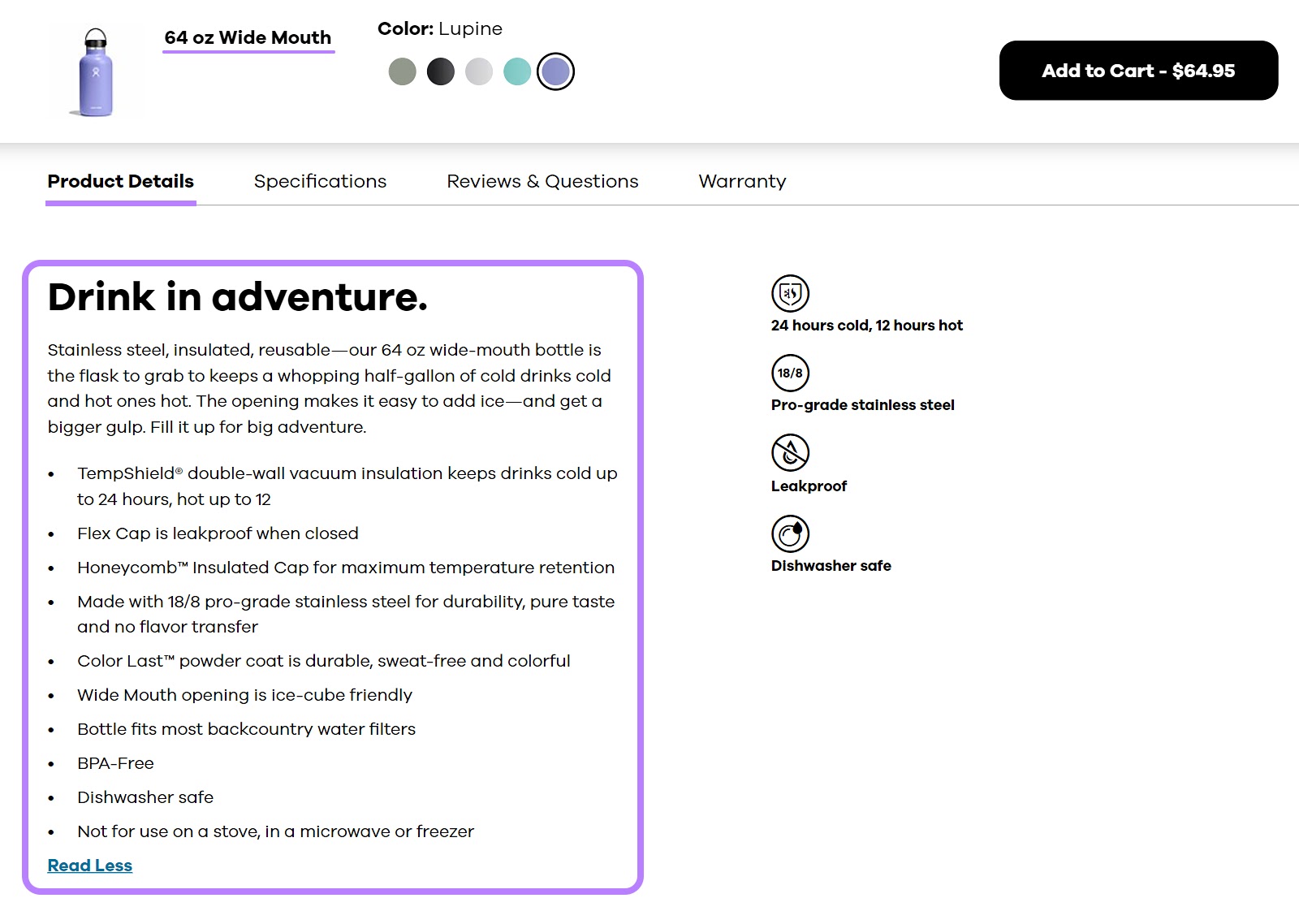
- Product images: Use high-quality, professional, and realistic images that showcase your products from different angles and perspectives. Include zoom and rotate features to allow customers to see the details of your products. Use a consistent style and background for your images to create a cohesive look.
- Product reviews: Encourage and display customer reviews on product pages to provide social proof and increase trust. Reviews can also help you improve your products and services based on customer feedback. Use a rating system, such as stars or numbers, to allow customers to easily express their satisfaction level.
7. Optimize Your Ecommerce Site
Keyword Research
- Identify relevant keywords related to your products or services using the Keyword Magic. You’ll use keywords in site copy, metadata, blog posts, and more.
- Prioritize long-tail keywords, which are more specific, to help reach your target audience
On-Page SEO
- Optimize meta titles and meta descriptions with target keywords. Ensure they accurately describe the page content and encourage clicks
- Include keywords naturally in headings (H1, H2, etc.) and throughout the content
- Ensure URLs are clean, descriptive, and contain relevant keywords
- Optimize image alt tags with descriptive keywords
Site Speed and Performance
- Optimize images and use compression techniques to reduce file sizes
- Minimize HTTP requests by combining CSS and JavaScript files
- Use a content delivery network (CDN) to deliver content faster to users across the globe
- Enable browser caching to reduce server load and improve load times for returning visitors
Technical SEO
- Ensure your site architecture is crawlable by search engine bots through proper use of internal linking and XML sitemaps
- Fix broken links and 404 errors to improve user experience and maintain crawlability
- Implement schema markup to provide search engines with additional context about your products, reviews, and business information
- Use a tool like Site Audit to get automatic updates on the health of your site, including guidance on how to fix any issues
8. Create Processes for Inventory, Fulfillment, and Shipping
Shipping and logistics are crucial aspects of running an ecommerce business.
Here are some tips on creating a process to manage these tasks:
- Encourage free local pickup if you run a local ecommerce brand to save on shipping costs
- Provide free shipping for products that meet a specified amount. This can incentivize customers to spend more and reduce cart abandonment rates.
- Give accurate delivery date estimates to manage customer expectations and improve customer satisfaction and trust
- Create a self-service returns portal so shoppers can return products without human assistance. This can streamline the return process and reduce customer service costs.
- Opt for shipping carriers with automation capabilities to save time and money by automating tasks like label printing, order fulfillment, and shipping confirmation
- Implement an inventory management system to keep track of your stock levels to help avoid overstocking or running out of products
9. Deliver Great Customer Service
Good customer support can also help you generate positive reviews, which are a powerful form of social proof that can influence other shoppers’ decisions.
Here are some actionable steps to improve your customer service:
- Offer multiple communication channels: Make it easy for customers to reach you by providing various options, such as phone, email, live chat, and social media. Set up chatbots to answer common questions and provide immediate support 24/7.
- Address customer inquiries promptly: Respond to your customers’ questions and complaints as quickly as possible. Aim to resolve issues within the first contact and follow up until the customer is satisfied. Use tools like Zendesk or Freshdesk to manage customer interactions and track response times.
- Have a fair return policy: A clear return policy can reduce customer hesitation and increase conversions. Ensure your policy is easy to find and understand on your website. Consider offering free returns or exchanges. You can also extend the return window to give customers more flexibility.
- Create a review management process: Encourage customers to leave feedback on your products and services. Send them an email after their purchase, offer incentives, or use a review platform like Trustpilot or Yotpo. Monitor and respond to your reviews, both positive and negative.
10. Scale
Once your site is up and running, think about growth. Here are some ideas to help scale your ecommerce business:
- Explore other traffic sources: Try new traffic sources like social media platforms, paid advertising, and email marketing. Leverage marketplaces like eBay and Amazon to drive more traffic to your products.
- Amplify customer retention: Introduce a customer loyalty program or referral program to help reward loyal customers
- Build a team: As your ecommerce business grows, hiring help may become a necessity for your operation to run smoothly. Consider investing in a customer support team, digital marketers, and/or comprehensive shipping and logistics solutions.
How to Promote an Ecommerce Website
Here are various ways to effectively promote your ecommerce website:
Content Marketing
A blog is a webpage that’s regularly updated with content relevant to your target customers’ needs, interests, and problems.
By creating blog posts that provide valuable information, tips, advice, or solutions, you can attract and engage your potential customers, build trust and authority, and increase conversions.
Each blog post should target a specific, relevant keyword. By targeting keywords, you can optimize your content for search engines and help your customers find your site.
Use the Keyword Magic Tool to decide which keywords are worth targeting.
Here’s how.

Enter your target keyword, select your country, and click the green “Search” button. In this example, we’ll use “smart home.”
Now, you’ll see a detailed report of your target keyword.
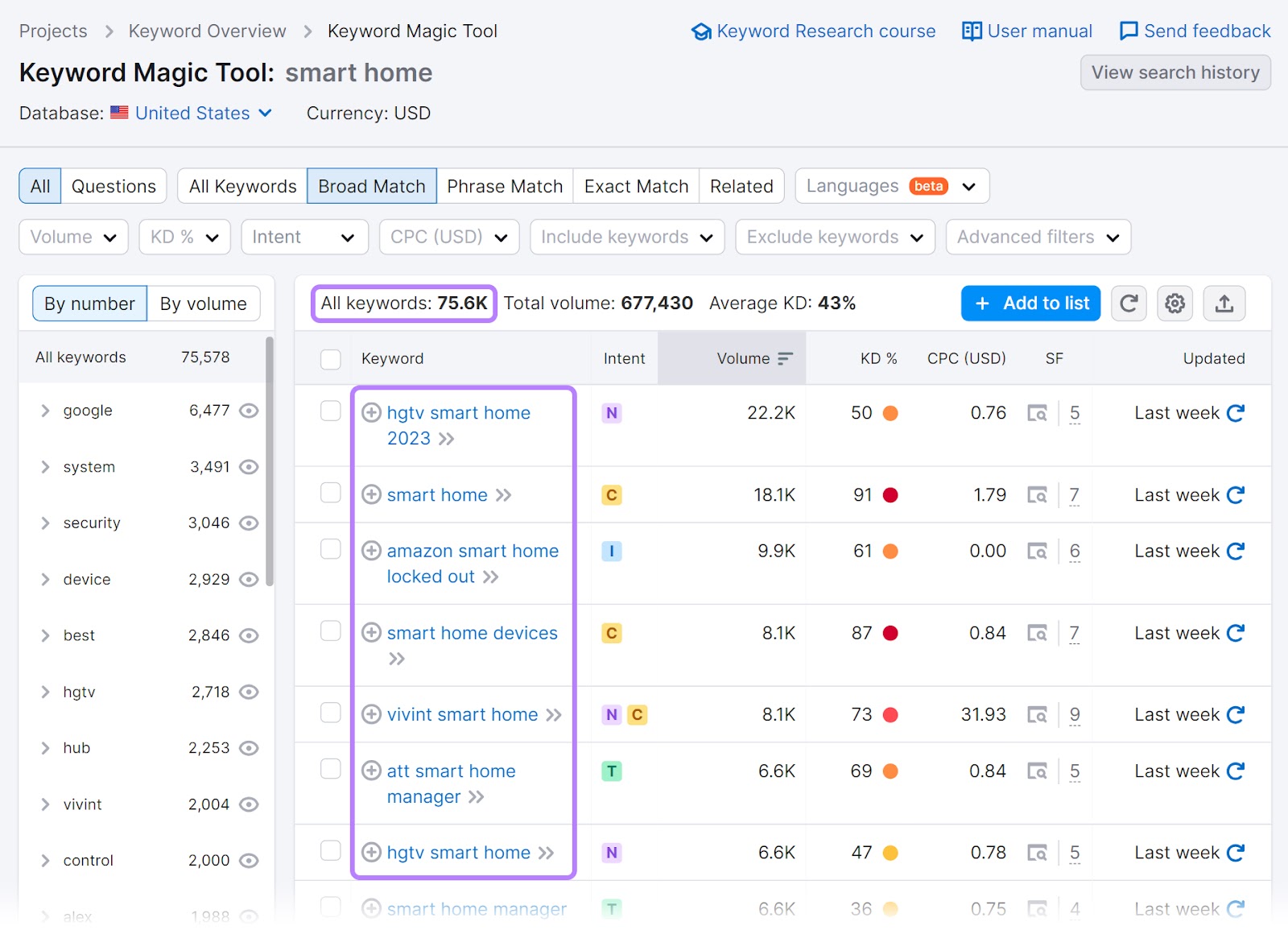
The tool generates a list of keyword suggestions based on the keyword entered. In our instance, we have over 75,000 suggestions.
Filter the results by "Keyword Difficulty,” which sorts keywords based on how hard they are to rank for.
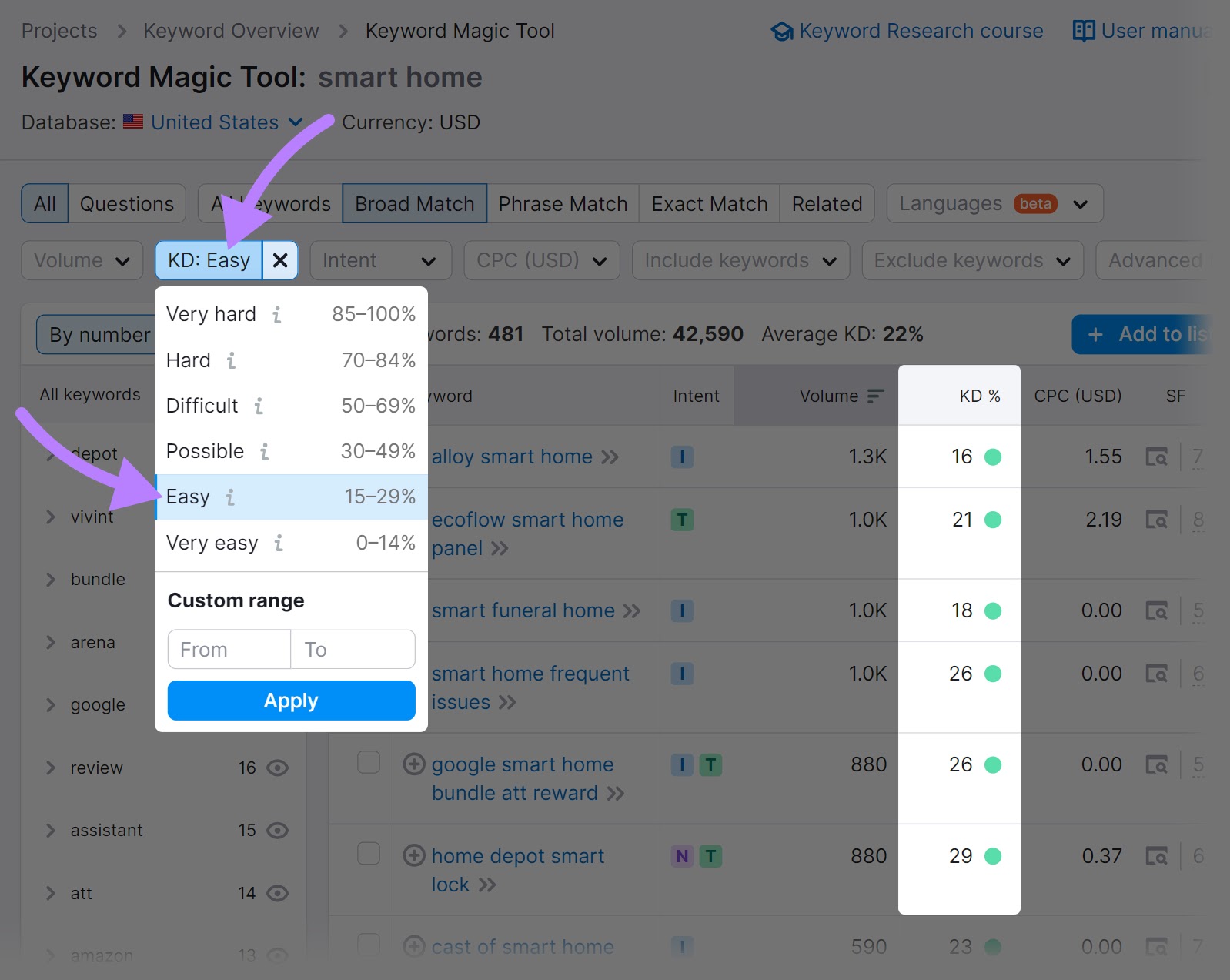
Check the box to the left of the keywords you want to target to add them to a list.
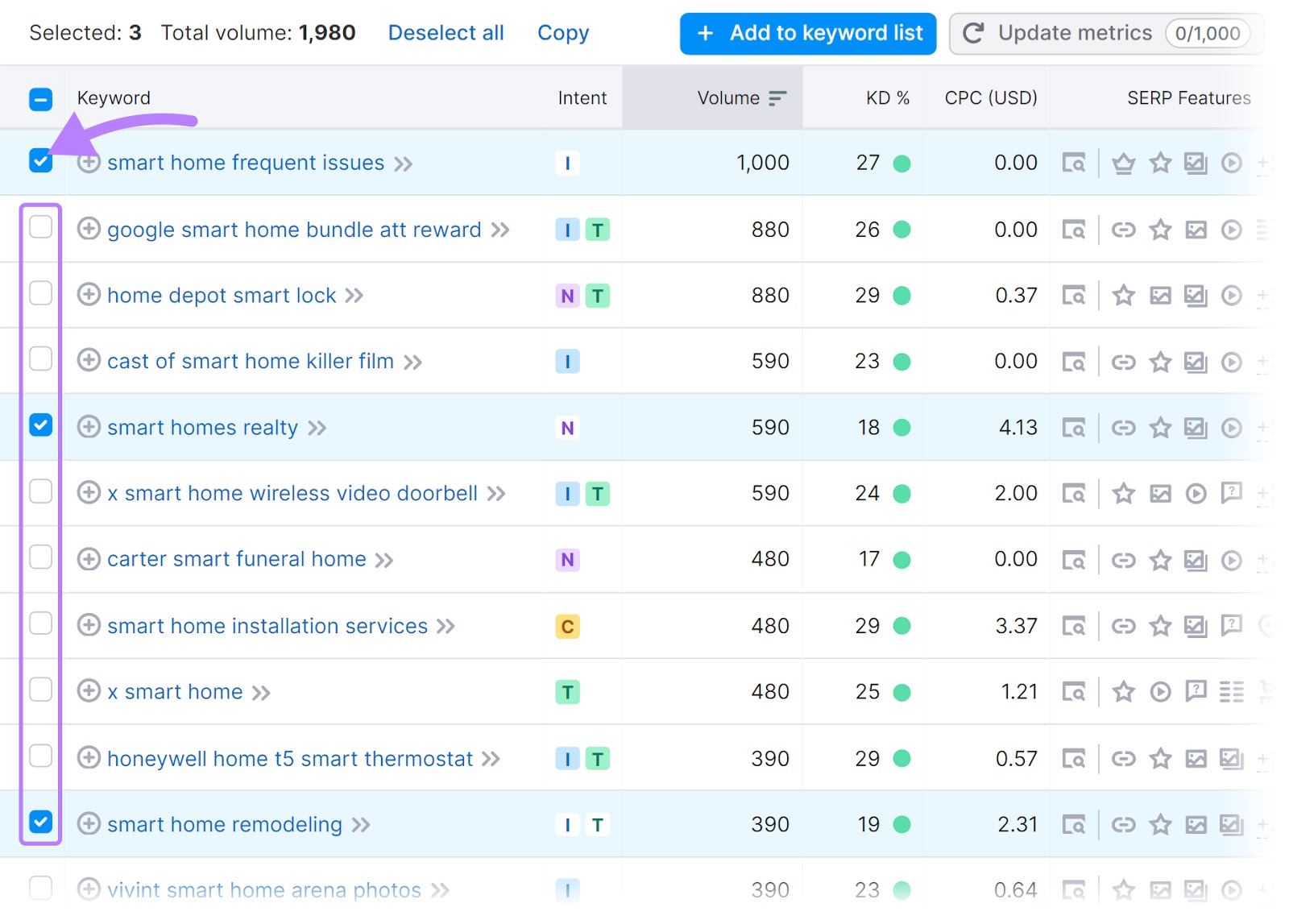
Click “Add to keyword list” to save to an existing list or create a new one by clicking on the text box. Click the checkmark to save.
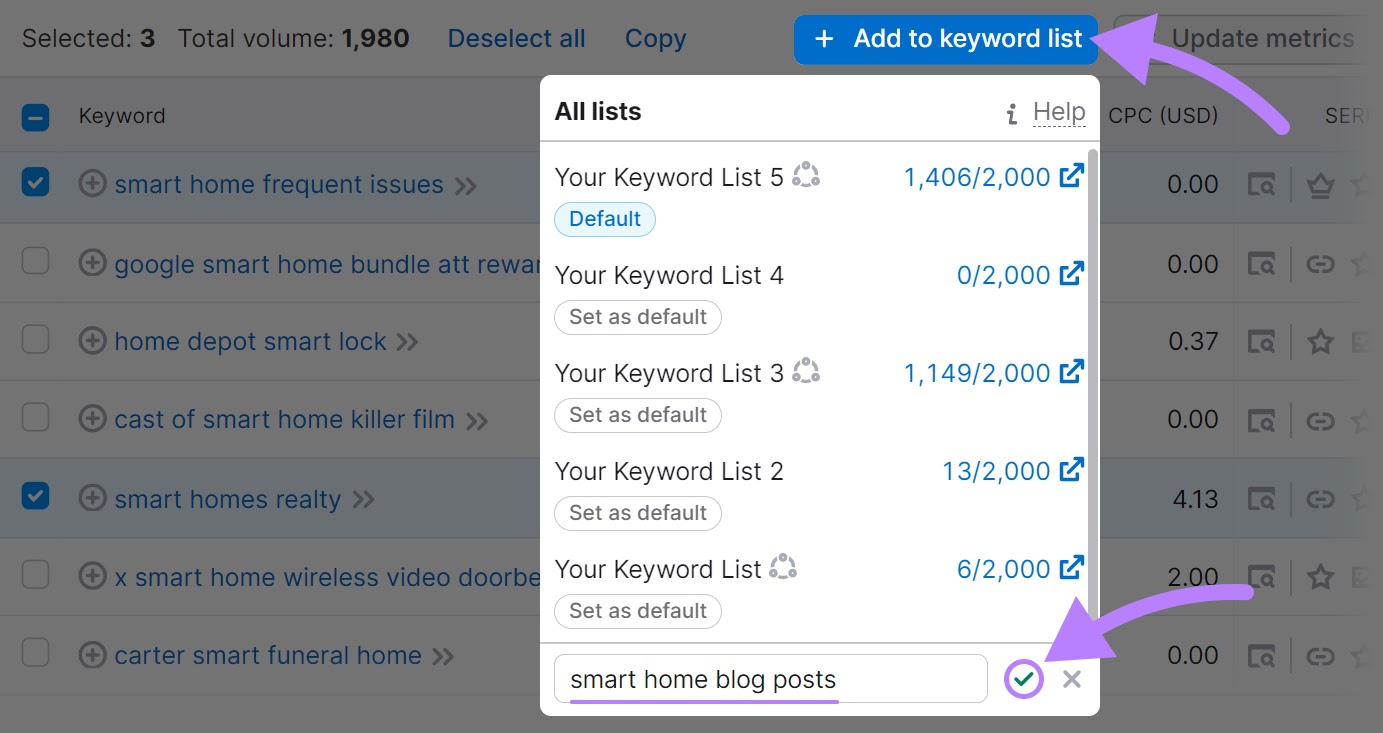
Now, build a content strategy around your niche and the target keywords you want to rank for.
Targeting low-competition keywords makes it more likely your content will rank, which can help you establish visibility and authority in your industry.
Social Media Marketing
Social media platforms like Facebook, Instagram, and Pinterest provide powerful opportunities to engage your target audience, build brand awareness, and promote your ecommerce site.
Take advantage of native social selling features, which are tools that allow users to buy products directly from social media platforms without leaving the app or website.
For example, Instagram has a feature called Instagram Shopping, which lets users browse and purchase products from their favorite brands and creators.
Pinterest has buyable pins that make it easy for users to buy products on the app or website. These pins have a blue price tag and an "Add to Bag" button. You can pay with a credit card or Apple Pay, and the seller will get your order details to fulfill it.
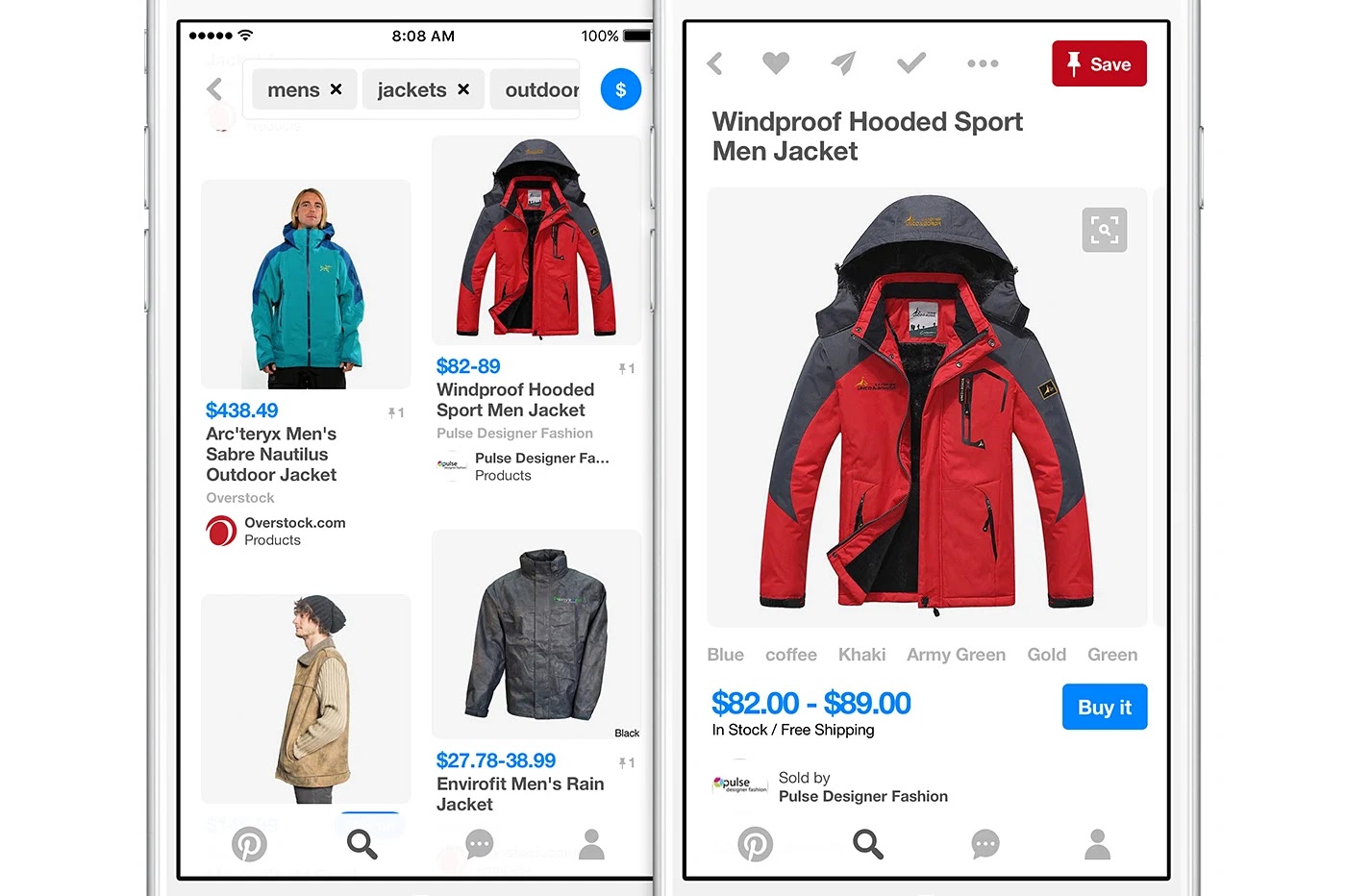
Image Source: eCommerce Insiders
Facebook and Instagram also have shoppable posts and videos, which let users buy products in the images or videos. Marked with a shopping bag icon, they have a "View Products" or "Shop Now" button. Users can tap on products to see details and purchase on the seller's website or in the app.
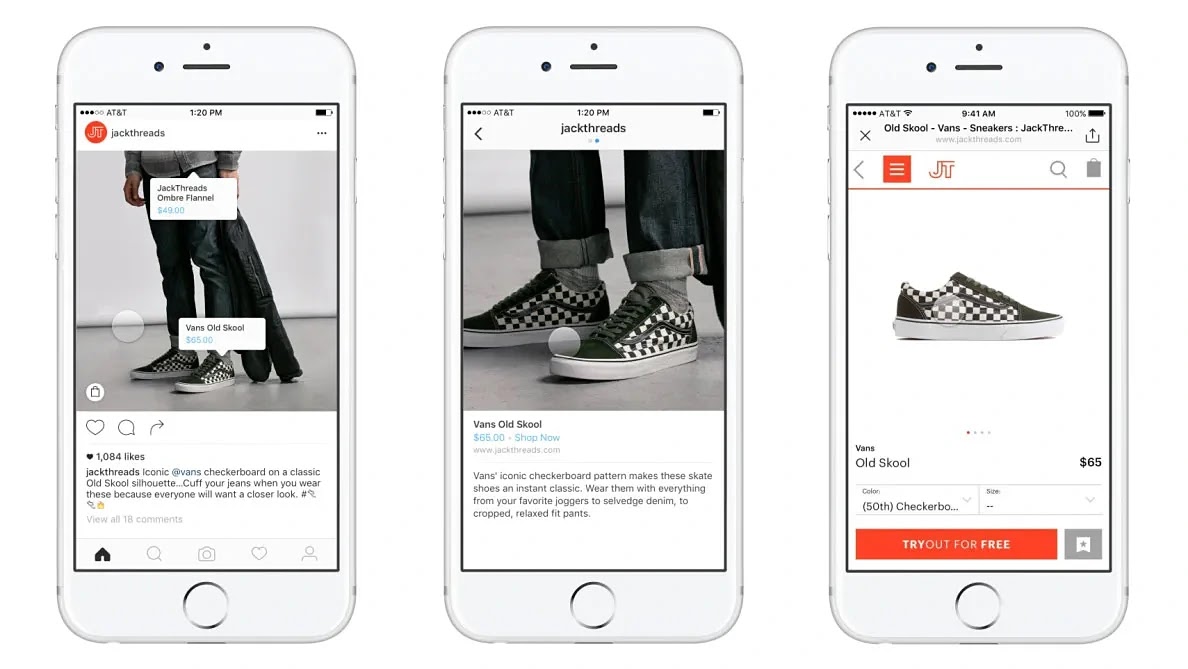
Image Source: TechCrunch
Instagram has another feature called “Instagram Shop.” This allows ecommerce businesses to create a digital storefront on their Instagram profile. Users can browse and buy products directly from the Instagram app without leaving the platform.
For example, Beardbrand, a men's grooming company, showcases products in its Instagram Shop.
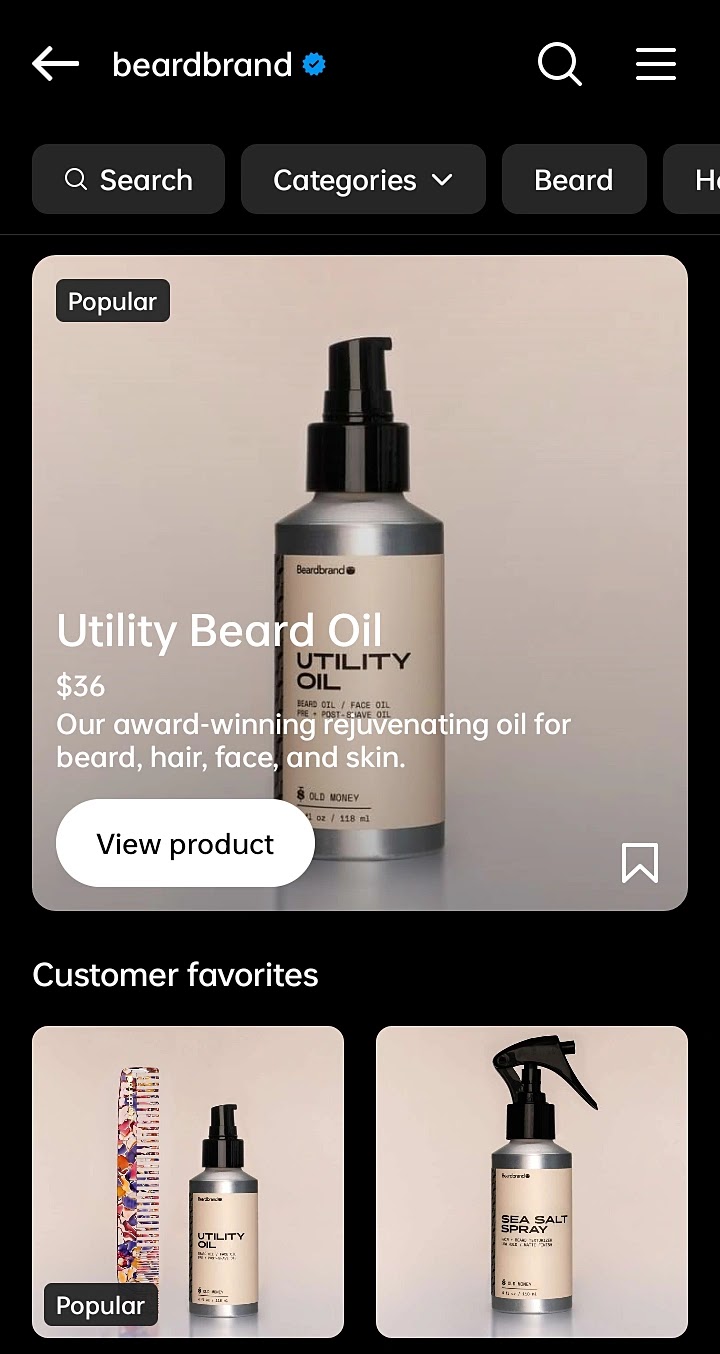
Use relevant hashtags in your social media content. Ideal hashtags not only enable you to target the right people, but also reach more potential customers.
Use local hashtags to reach local customers. For instance, if you sell handmade jewelry in New York, use hashtags such as #handmadejewelry, #jewelryoftheday, #newyorkstyle, #nycjewelry, and #shoplocalnyc.
Further reading: A 6-Step Guide to Social Media for Small Businesses
Email Marketing
Email marketing is one of the most effective ways to promote your online store and increase sales.
To get started with email marketing, here are a few best practices:
Build an Email List
Collect addresses of potential and current customers using a lead capture form on your website. Offer incentives like free shipping, discounts, or lead magnets like ebooks to entice visitors to sign up for your email list.
For example, coffee brand Alfred offers a discount to those who sign up for its email newsletter.
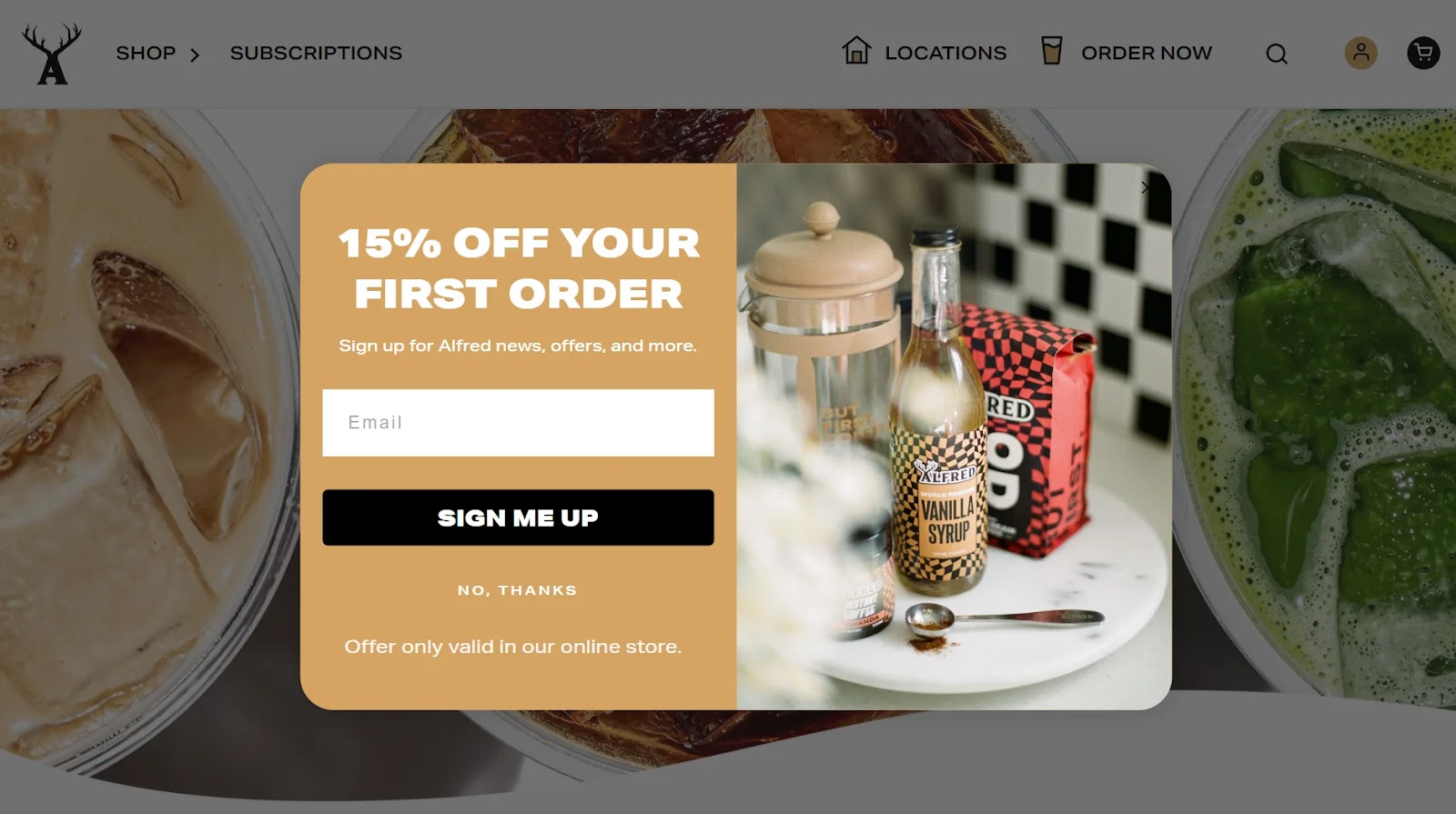
Segment Your Email List
Segmentation allows you to send personalized offers to subscribers based on their interests, preferences, and purchase history. To increase conversions and customer loyalty.
Send a Welcome Series
A welcome series can make new subscribers feel special. Include exclusive offers for new customers and discount coupons. Introduce your brand, showcase your products, and provide value to your customers.
Recover Lost Sales
Don’t just accept abandoned carts. Send an abandoned cart email sequence to shoppers who didn’t complete their purchase. Remind them of the items they left behind, offer a limited-time discount, or provide social proof to persuade them to buy.
Further reading: How to Build an Engaging Ecommerce Email Marketing Strategy
Pay-Per-Click (PPC) Advertising
Pay-per-click (PPC) advertising is a form of online marketing where you pay a fee each time someone clicks on your ad.
Facebook and Pinterest are great for beginners. These platforms allow you to create and display ads based on user demographics, interests, and behaviors.
To create and run a successful PPC campaign, follow these steps:
- Define your goals and budget: Decide what you want to achieve with your PPC campaign, such as increasing traffic, sales, or brand awareness. Set a realistic and flexible budget you can adjust based on performance.
- Choose your platform and ad format: Select the platform that best suits your products and audience, such as Facebook or Pinterest. Choose the ad format that showcases your products, such as carousel, video, or collection ads.
- Monitor your campaign: Launch your campaign and test different elements, such as headlines, images, copy, and call-to-action buttons, to see what works best.
Partnerships and Collaborations
Collaborate with other businesses to benefit from shared marketing efforts.
Use these ecommerce partnership tactics:
- Hold a joint contest to boost your email subscribers and increase brand visibility
- Promote other brands on social media via product mentions and shoutouts
- Advertise your products through a social media influencer with an audience similar to yours
Here’s an example of Purina UK & Ireland teaming up with an Instagram influencer to promote their cat food:

How to Track Ecommerce Website Success
Here are key metrics and methods to track and measure the success of your ecommerce website.
Website Traffic
These are the top website traffic metrics you’ll want to track:
- Total website visits: how many people visit your website
- Unique visitors: how many people are new visitors
- Page views: how many pages visitors view during their visit
These metrics are fundamental to understanding the overall performance of your website.
Use web analytics tools like Google Analytics to track website traffic. Monitor trends over time and identify traffic sources (organic, paid, social, etc.).
Conversion Rate
Conversion rate is the percentage of website visitors who complete a desired action like making a purchase. This metric is critical for any ecommerce business because it measures how well your website turns visitors into customers.
Calculate conversion rate bydividing the number of conversions (e.g., purchases) by the total number of website visitors and multiplying by 100.
There are a lot of conversion rate optimization (CRO) tactics that can increase conversions, like improving page load speed and tailoring messaging to your audience.
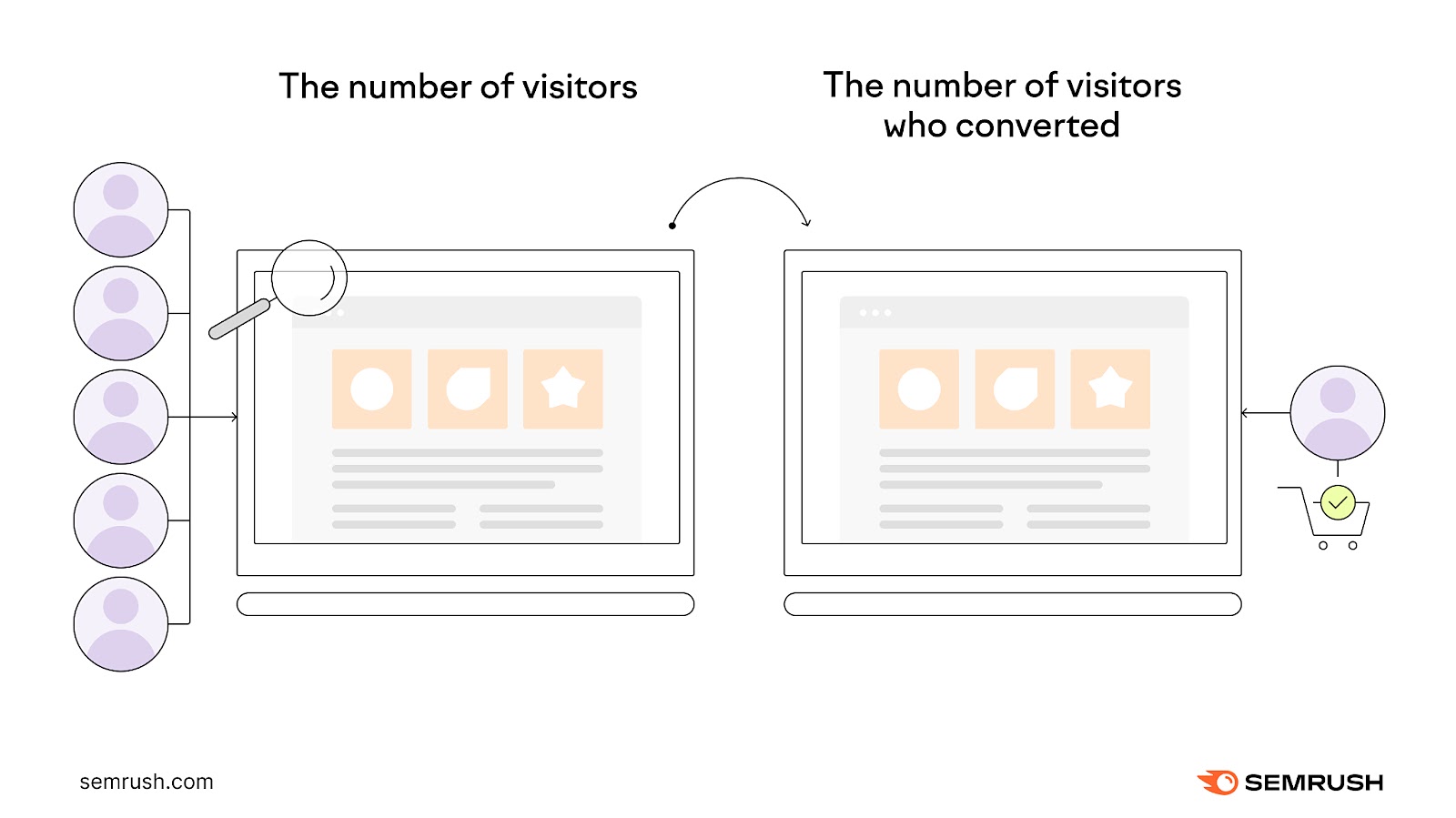
Average Order Value (AOV)
The average order value (AOV) is the average amount spent by a customer in a single transaction.
In other words, how much your customers typically spend when they make a purchase. It can provide insights into your pricing strategy and customer buying behavior.
To calculate, divide the total revenue by the number of orders. Monitor changes in AOV over time. Use a Google spreadsheet with the following formula to keep track of this metric.
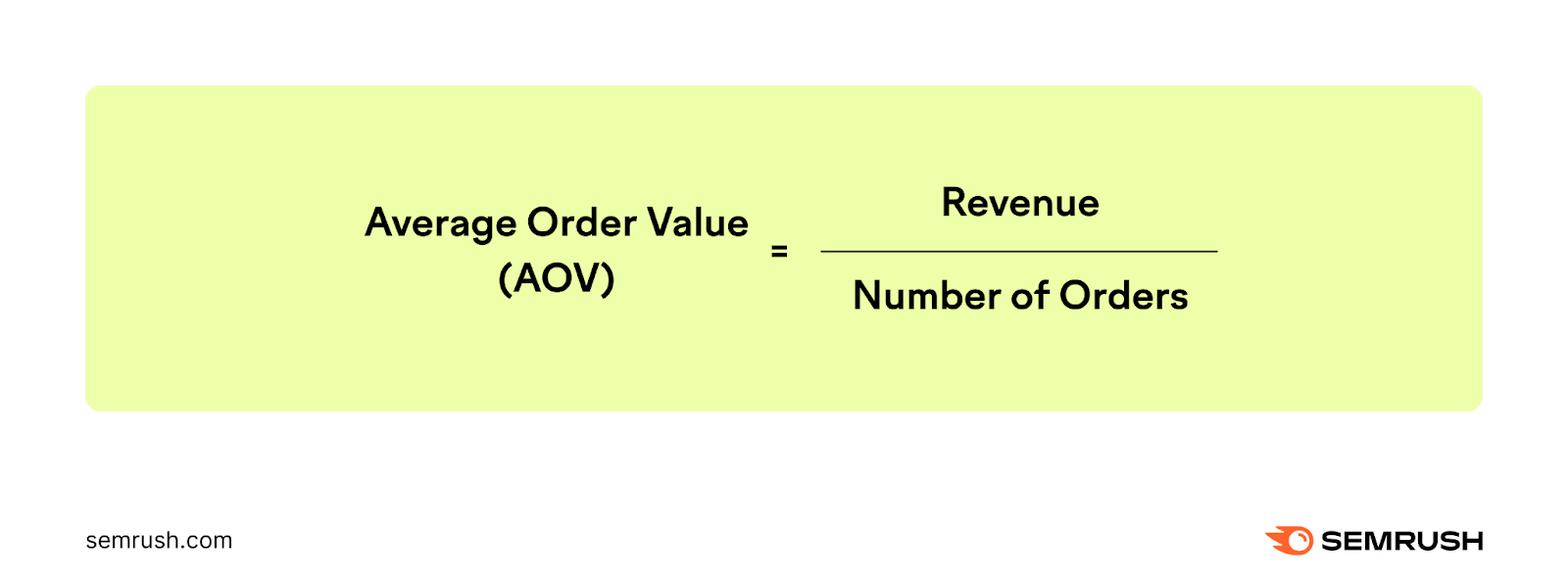
Customer Acquisition Cost (CAC)
Customer acquisition cost (CAC) is the cost associated with acquiring a new customer.It’s a key metric that informs how much you are spending to attract each new customer. It helps determine the efficiency of your marketing efforts.
To measure it, divide your total marketing expenses by the number of new customers acquired during a specific period.
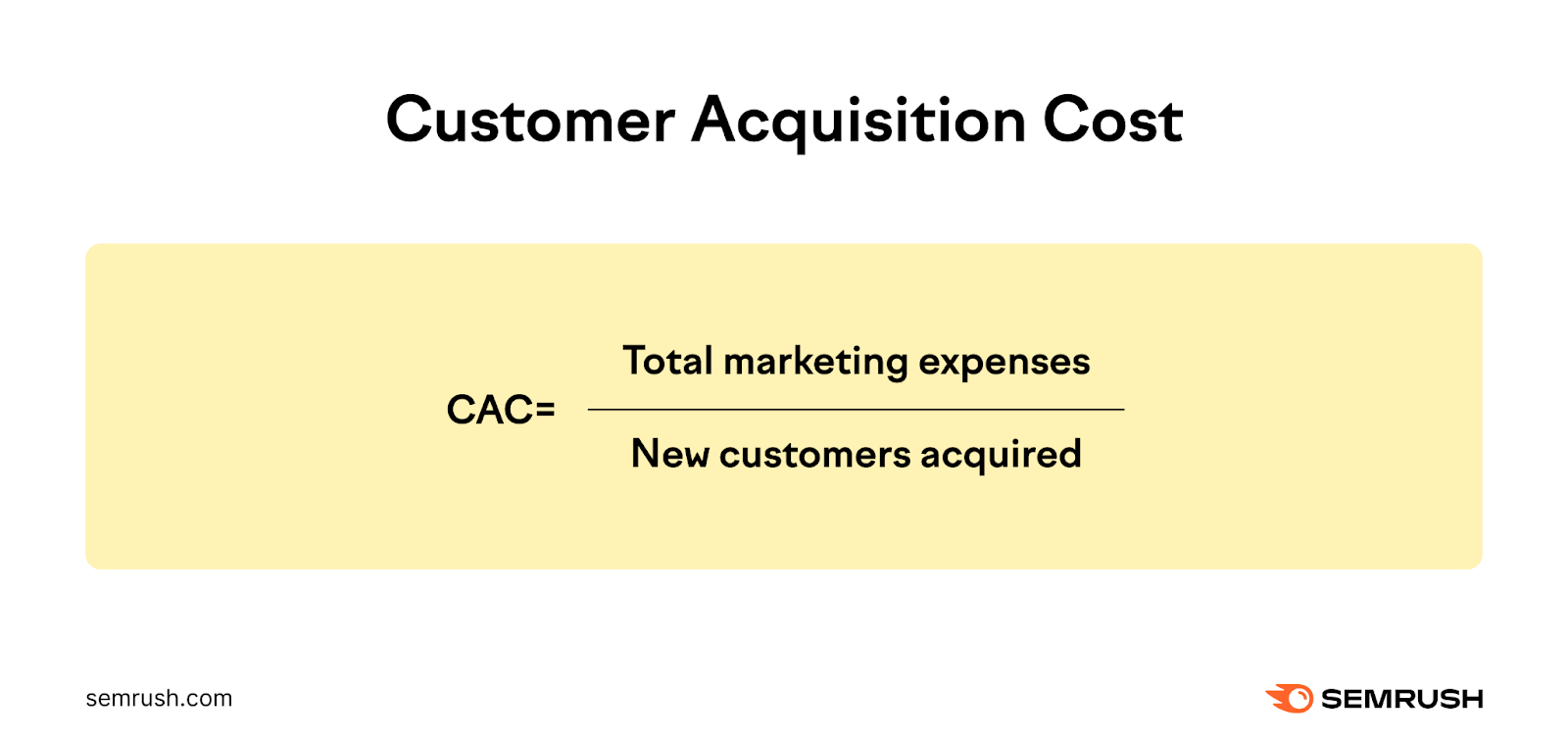
Cart Abandonment Rate
Cart abandonment rate is the percentage of users who add products to their cart but do not complete the purchase. This metric indicates how often potential purchases are not completed, which can highlight issues with the checkout process or pricing
To calculate it, divide the number of completed transactions by the number of initiated transactions and subtract one. Multiply by 100 for the abandonment rate.
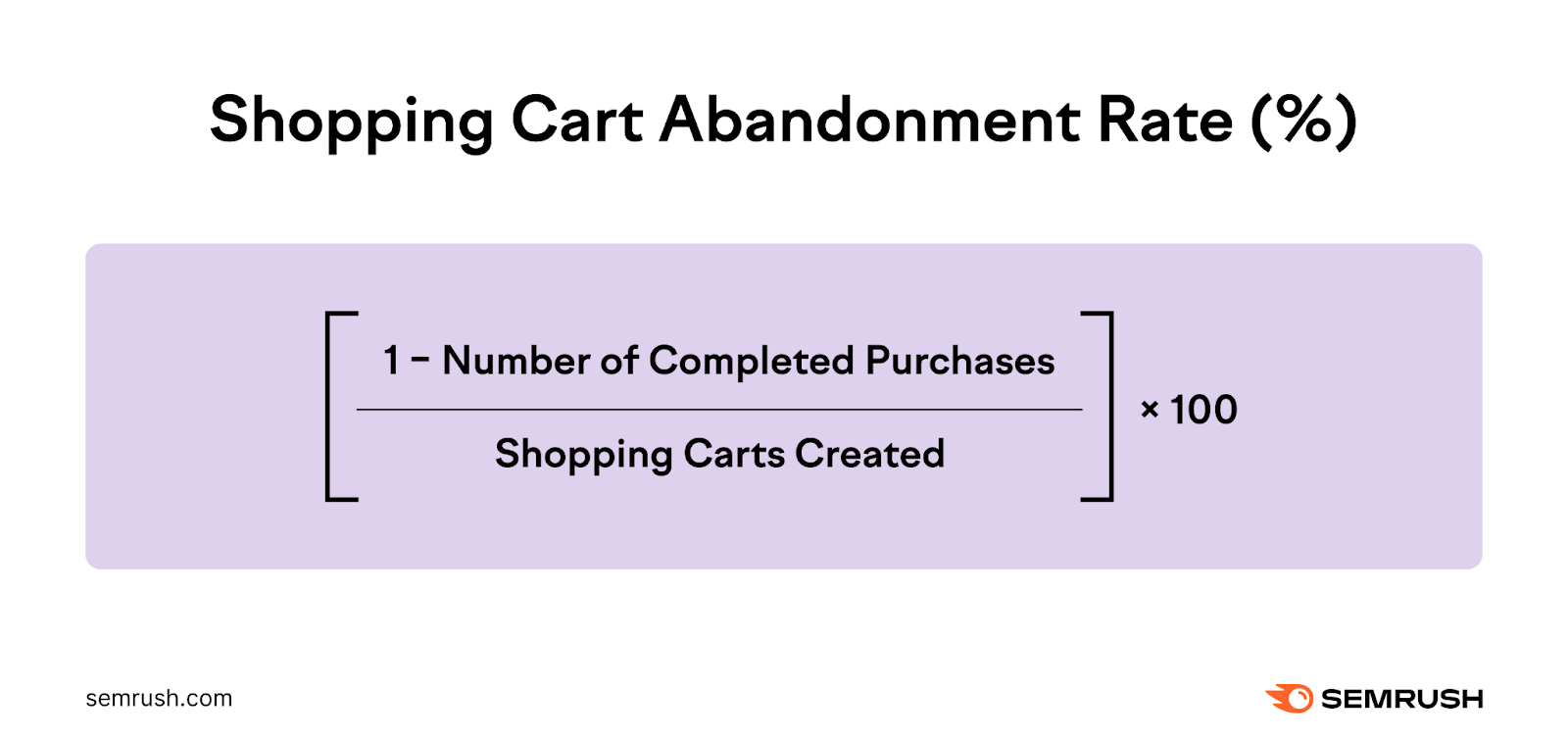
Here’s the full formula:
Shopping Cart Abandonment Rate (%) = [1 − Number of Completed Purchases / Shopping Carts Created] × 100
For example, imagine we have 400 shopping carts created and 120 completed purchases, using our formula, the calculation will look like this:
Shopping Cart Abandonment Rate (%) = [1 − 120 / 400] × 100
= [1−0.3] ×100
= 0.7×100
= 70%
Our shopping cart abandonment rate for this instance is 70%.
Customer Lifetime Value (CLV)
Customer lifetime value (CLV) is the predicted net profit attributed to the entire future relationship with a customer. It helps you understand the value of keeping your customers over the long term. It can guide your customer retention strategies and marketing spend.
Calculate CLV by multiplying the average purchase value by the average purchase frequency and then multiplying by the average customer lifespan. The basic formula looks like this:
Customer Lifetime Value = Customer Value x Average Customer Lifespan
As you can see, you must know your customer value and the average customer lifespan before you can calculate your CLV. Here’s how the full CLV formula looks:
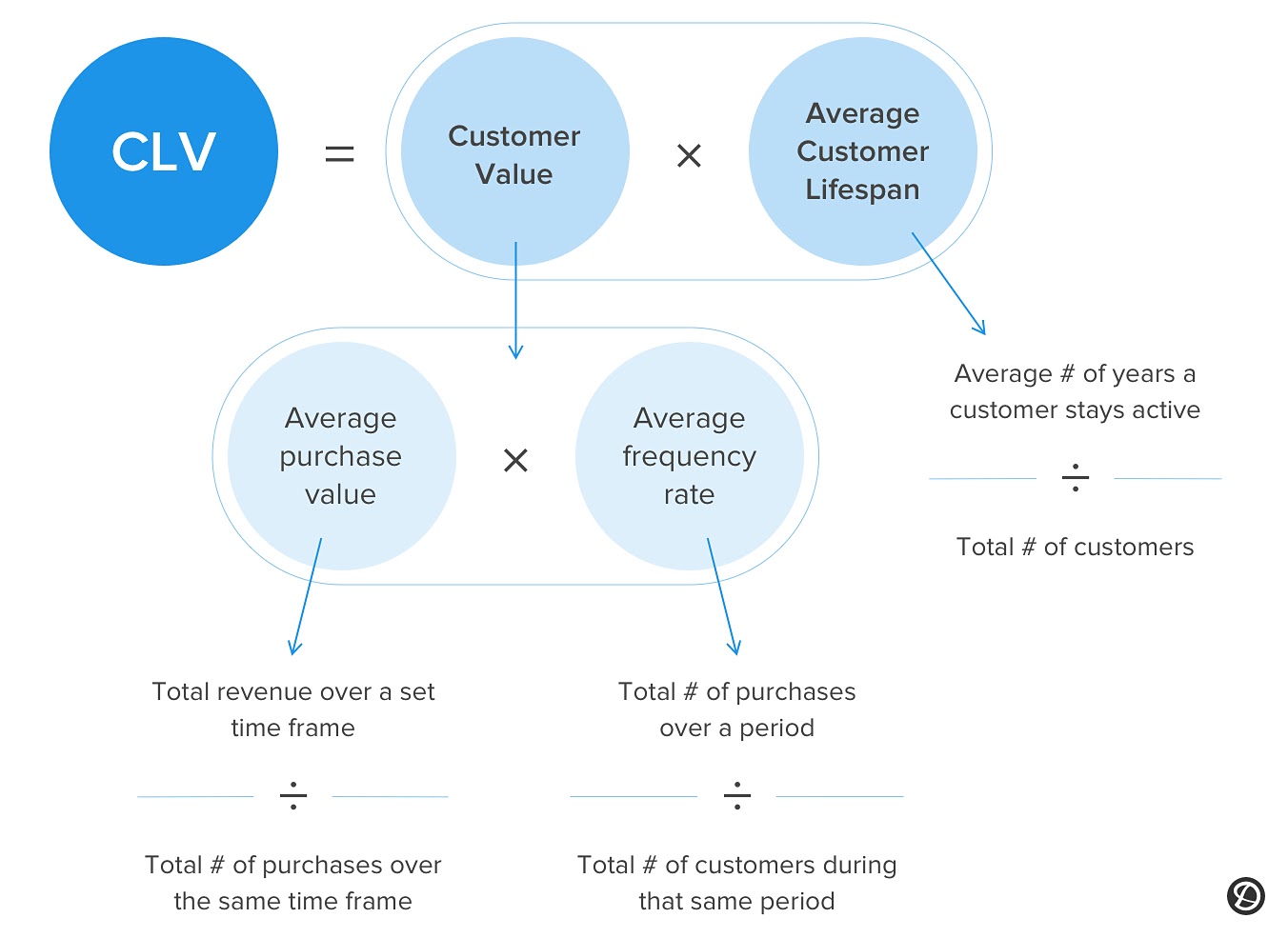
Image Source: Delighted
Website Engagement
Website engagement metrics, such as bounce rate, time on site, and click-through rate should be checked regularly. These metrics provide insights into how users interact with your website. High engagement is typically a sign of good user experience and relevant content.
Monitor the above metrics in your Google Analytics dashboard to assess the effectiveness of your website design, content, and user experience.
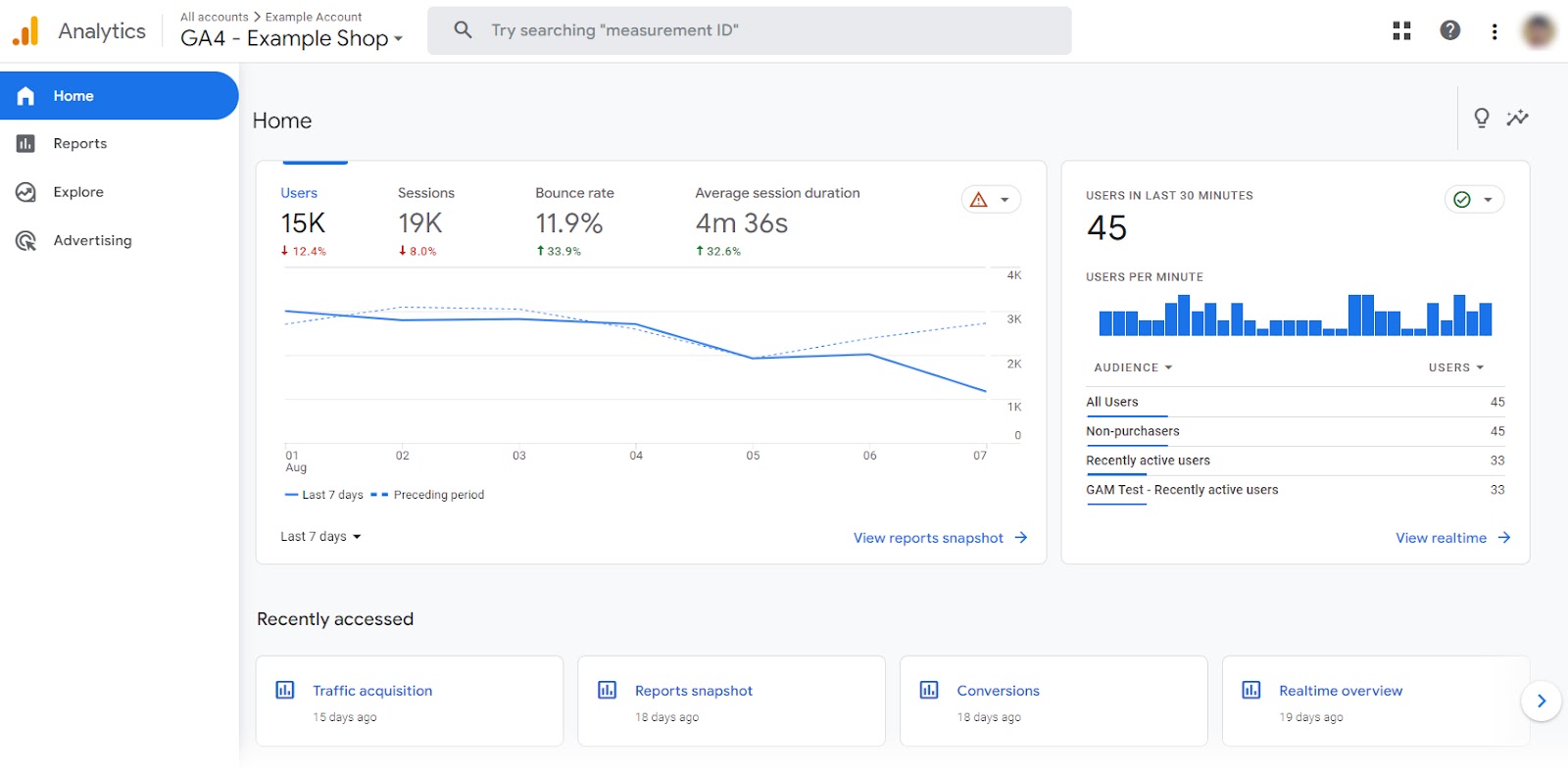
Further reading: Google Analytics for Beginners: Getting Started with GA4
Frequently Asked Questions
What is a multi-vendor ecommerce website?
A multi-vendor ecommerce website is an online platform where many sellers can sell their products or services.
What is ecommerce website design?
Ecommerce website design refers to the process of creating and structuring an online platform specifically for selling products or services over the internet. It involves the integration of various elements such as layout, user interface, navigation, visual aesthetics, functionality, and security features to create a seamless and enjoyable shopping experience for users.
What is ecommerce website development?
Ecommerce website development refers to the process of creating, designing, and implementing an online platform that enables businesses to sell their products or services over the internet. It involves various stages from conceptualization to launch, including planning, design, development, testing, and deployment.
What is needed to build an ecommerce website?
To build an ecommerce website, you need reliable web hosting for accessibility, a memorable domain name reflecting your brand, and an ecommerce platform equipped with key features such as product listings, shopping cart functionality, payment processing, and order management.
Optimal user experience is achieved through user-friendly website design, either by hiring a web designer or using optimized templates.
Integration with secure payment gateways accommodating various payment methods is essential, alongside the implementation of security measures like SSL certificates for data encryption.
Effective marketing strategies, including SEO, email campaigns, social media engagement, and online advertising, are crucial for driving traffic and increasing sales.
Get Started With Ecommerce
Now that you have a solid grasp of what an ecommerce website is, take advantage of tools to track and grow your ecommerce business.
Start by using Keyword Magic Tool to research terms for metadata and on-page optimization and Site Audit to track your site’s health. These tools can help you improve your rankings and provide a great user experience.
